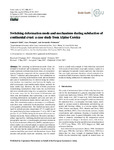Switching deformation mode and mechanisms during subduction of continental crust: a case study from Alpine Corsica
| dc.contributor.author | Molli, G | |
| dc.contributor.author | Menegon, Luca | |
| dc.contributor.author | Malasoma, A | |
| dc.date.accessioned | 2017-07-17T10:42:52Z | |
| dc.date.accessioned | 2017-08-11T10:29:22Z | |
| dc.date.available | 2017-07-17T10:42:52Z | |
| dc.date.available | 2017-08-11T10:29:22Z | |
| dc.date.issued | 2017-07-13 | |
| dc.identifier.issn | 1869-9510 | |
| dc.identifier.issn | 1869-9529 | |
| dc.identifier.uri | http://hdl.handle.net/10026.1/9778 | |
| dc.description.abstract |
The switching in deformation mode (from distributed to localized) and mechanisms (viscous versus frictional) represent a relevant issue in the frame of crustal deformation, being also connected with the concept of the brittle–ductile transition and seismogenesis. In a subduction environment, switching in deformation mode and mechanisms and scale of localization may be inferred along the subduction interface, in a transition zone between the highly coupled (seismogenic zone) and decoupled deeper aseismic domain (stable slip). However, the role of brittle precursors in nucleating crystal-plastic shear zones has received more and more consideration being now recognized as fundamental in some cases for the localization of deformation and shear zone development, thus representing a case in which switching deformation mechanisms and scale and style of localization (deformation mode) interact and relate to each other. This contribution analyses an example of a millimetre-scale shear zone localized by brittle precursor formed within a host granitic protomylonite. The studied structures, developed in ambient pressure–temperature (P–T) conditions of low-grade blueschist facies (temperature T of ca. 300 °C and pressure P ≥ 0. 70 GPa) during involvement of Corsican continental crust in the Alpine subduction. We used a multidisciplinary approach by combining detailed microstructural and petrographic analyses, crystallographic preferred orientation by electron backscatter diffraction (EBSD), and palaeopiezometric studies on a selected sample to support an evolutionary model and deformation path for subducted continental crust. We infer that the studied structures, possibly formed by transient instability associated with fluctuations of pore fluid pressure and episodic strain rate variations, may be considered as a small-scale example of fault behaviour associated with a cycle of interseismic creep and coseismic rupture or a new analogue for episodic tremors and slow-slip structures. Our case study represents, therefore, a fossil example of association of fault structures related to stick-slip strain accommodation during subduction of continental crust. | |
| dc.format.extent | 767-788 | |
| dc.language | en | |
| dc.language.iso | en | |
| dc.publisher | Copernicus GmbH | |
| dc.relation.replaces | http://hdl.handle.net/10026.1/9623 | |
| dc.relation.replaces | 10026.1/9623 | |
| dc.title | Switching deformation mode and mechanisms during subduction of continental crust: a case study from Alpine Corsica | |
| dc.type | journal-article | |
| dc.type | Journal Article | |
| plymouth.author-url | https://www.webofscience.com/api/gateway?GWVersion=2&SrcApp=PARTNER_APP&SrcAuth=LinksAMR&KeyUT=WOS:000413192000001&DestLinkType=FullRecord&DestApp=ALL_WOS&UsrCustomerID=11bb513d99f797142bcfeffcc58ea008 | |
| plymouth.issue | 4 | |
| plymouth.volume | 8 | |
| plymouth.publication-status | Published | |
| plymouth.journal | Solid Earth | |
| dc.identifier.doi | 10.5194/se-8-767-2017 | |
| plymouth.organisational-group | /Plymouth | |
| plymouth.organisational-group | /Plymouth/Faculty of Science and Engineering | |
| plymouth.organisational-group | /Plymouth/REF 2021 Researchers by UoA | |
| plymouth.organisational-group | /Plymouth/REF 2021 Researchers by UoA/UoA07 Earth Systems and Environmental Sciences | |
| dcterms.dateAccepted | 2017-06-07 | |
| dc.identifier.eissn | 1869-9529 | |
| dc.rights.embargoperiod | No embargo | |
| rioxxterms.versionofrecord | 10.5194/se-8-767-2017 | |
| rioxxterms.licenseref.uri | http://www.rioxx.net/licenses/all-rights-reserved | |
| rioxxterms.licenseref.startdate | 2017-07-13 | |
| rioxxterms.type | Journal Article/Review | |
| plymouth.oa-location | http://www.solid-earth.net/8/767/2017/se-8-767-2017.pdf |


